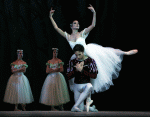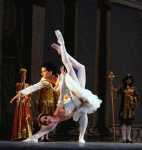|
Back
The Magic of the Dance Orange County
Segerstrom Hall
06/15/2011 - & 16, 17, 18, 19 June 2011
Adolphe Adam: Giselle (excerpts)
Pyotr Ilyich Tchaikovsky: The Sleeping Beauty, The Nutcracker, Swan Lake (excerpts)
Léo Delibes: Coppélia (excerpts)
Ludwig Minkus: Don Quixote (excerpts)
Louis Moreau Gottschalk: Gottschalk Symphony (excerpt)
The Ballet nacional de Cuba, soloists and corps de ballet:
Giselle: Anette Delgado (Giselle), Dani Hernández (Albrecht), Ernesto Díaz (Hilarion), Amaya Rodríguez (Queen of the Wilis), Corps de ballet
Ricardo Reymena (Set Designer), Salvador Fernández (Costume Designer)
The Sleeping Beauty: Yanela Pinera (Princess Aurora), Alfredo Ibánez (Prince Desiré), Corps de ballet (Polonaise)
Salvador Fernández (Set and Costume Designer)
The Nutcracker: Bárbara García (Sugarplum Fairy), Ernesto Álvarez (Cavalier), Lissi Báez & Marizé Fumero (Waltz of the Flowers), Corps de ballet
Isabel Santos (Set Designer), Salvador Fernández (Costume Designer - “Grand pas de deux”), Félix Avila (Costume Designer – “Waltz of the Flowers”)
Coppélia: Grettel Morejón (Swanilda), Osiel Gounod (Franz), Aymara Vasallo & Javier Sánchez (Mazurka Soloists), Corps de ballet
Ricardo Reymena (Set and Costume Designer)
Don Quixote: Viengsay Valdés (Kitri), Alejandro Virelles (Basil), José Losada (Espada), Amaya Rodríguez (Mercedes), Yanier Gómez/Camilo Ramos/Randy Crespo/Omar Morales/Roberto Vega/Edward González (Bullfighters), Majas (Corps de ballet)
Frank Alvarez (Set Designer), Salvador Fernández (Costume Designer)
Swan Lake: Sadaise Arencibia (Odette), Arián Molina (Prince Siegfried), David Martínez (Von Rothbart), Ivis Díaz/Aymara Vasallo (Two swans), Amanda Fuentes/Mercedes Piedra/Maureen Gil/Mayrel Martínez (Four swans), Corps de ballet
Ricardo Reymena (Set designer), Julio Castano (Costume Designer)
Louis Moreau Gottschalk: Bárbara García/Alejandro Virelles, Sadaise Arencibia/José Losada, Yanela Pinera/Ernesto Álvarez, Anette Delgado/Alejandro Virelles (Soloists), Corps de ballet
Erick Grass (Set Designer), Salvador Fernández (Costume Designer)
Pacific Symphony, Giovanni Duarte (Conductor)
Alicia Alonso (Choreographer), Luis Carlos Benvenuto (Stage Manager), Ruddy Artiles (Lighting Technician)

(© Nancy Reyes)
Few women have ever been awarded the title of prima ballerina assoluta, but in 1959 such an honor was given to Alicia Alonso for her remarkable contributions to dance. Alonso, still active at 90, has it all: accomplished dancer, instructor, diplomat and humanitarian. In 1948 Alonso returned to her native Havana, Cuba and founded her own ballet company. Desiring to promote the country’s cultural institutions, subsequently Fidel Castro’s Communist government helped bankroll and open what is now known as the Cuban National Ballet in 1960 with Alonso at the helm.
After an absence of eight years, Alicia Alonso’s Cuban National Ballet returns to Orange County for six performances only of The Magic of the Dance, a carefully apportioned compendium of 19th century classical ballet works reflecting a distinct Cuban style: sharp, brilliant steps attuned to the music alongside connective inflexions of the head and arms. Knowing this tidbit of information perhaps helps explain the interpretative movements that are subtly different than those originating from other ballet schools.
Each of the seven subsections is a mélange of dancers, set designers and costume designers with excerpted reshuffling of music by the composers. A flowered scrim drops after each tableau in order to change the richly hued but two dimensional backdrops. The Magic of the Dance moves along seamlessly.

(© Nancy Reyes)
All mini-productions are well executed, but some are better than others. The well known Romantic ballet Giselle begins the program and is arguably one of the best in which the corps de ballet’s synchronization is precise, capturing a perfect 10. Anette Delgado’s Giselle retains dignified finesse, and she demonstrates exhilarating footwork at the close of the curtain.
Ricardo Reymena’s colorful folk costuming is accentuated with brilliant lighting by Ruddy Artiles in Léo Delibes’ Coppélia. Particularly exhilarating is the “Mazurka” with its Swiss clockwork precision while Grettel Morejón steps into the role as a witty Swanilda with an extended session on pointe during the "Valse des heures" and then joining in with Osiel Gounod as Franz in a delightful pas de deux.

(© Nancy Reyes)
The Latin blood comes out in great fashion during Don Quixote featuring Alejandro Virelles’ dynamic grand jetés, Viengsay Valdés as Kitri with perky interjections prior to her famous 32 pirouettes in the “Kitri Variation.” It’s a joy to watch. Additionally, Alicia Alonso created splendid choreography using Salvador Fernández’ dazzling reddish orange capes for the “Bullfighters’ Dance.”

(© Nancy Reyes)
Yanela Pinera got off to a shaky start in The Sleeping Beauty, but she managed to recover nicely as the piece progressed. Her movements, however, appeared more quick and sharp, particularly in gradient arabesques, denoting fragmented grace and demure.
In Tchaikovsky's The Nutcracker "Waltz of the Flowers", headed up by Lissi Báez and Maríze Fumero alongside the corps de ballet, was fluid and connected, making creative use of garlands throughout the session; Bárbara García appeared to struggle and exuded but only a paltry dusting of lightness as the Sugarplum Fairy.
Swan Lake, on the other hand, demonstrated the true values of classical ballet that began with the Swans’ shimmering wings, all clearly well rehearsed. The famous pas de deux pairing of Sadaise Arencibia and Arián Molina was sophisticated and elegant despite some irksome and shaky notes stemming from the solo violin, diminishing the moment.
Ending the program was Gottschalk Symphony set against the abbreviated score of Louis Moreau Gottschalk’s Night of the Tropics symphony. The catchy samba-like rhythm began and ended with the corps de ballet stepping to the music in conga formation. The selection, albeit rather short, is colorful, zestful and happy, summing up the verve and élan found within the Cuban culture.
The Cuban National Ballet takes classical ballet to a new level, without crossing lines of established tradition. This respect and love of profession comes across wholeheartedly and is a sure bet to please anyone anytime.
Christie Grimstad
|